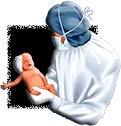|
A fair amount of research, some of which we've reported in
previous issues, suggests that exercise can positively affect
bone content.
The majority of this research has investigated bone mineralization
in adults. However, because evidence supports the notion that
mechanical loading on bones and joints can stimulate growth,
the authors of this study in Pediatrics evaluated whether
exercise could exert the same bone-building influence in infants.
The study group consisted of 32 preterm infants at substantial
risk for inadequate bone mineralization because of their premature
entry into the world. Sixteen infants were assigned to a physical
activity (PA) subgroup, with the remaining 16 comprising the
control group. Physical activity involved range of motion
against passive resistance to all extremities, five to 10
minutes daily.
 Infants in the physical activity group showed greater gains
in body weight, forearm bone length, bone area, bone mineral
content, and fat-free mass compared with infants in the control
group. These results were noted despite similar nutrient intake
between groups at baseline and throughout the study period.
Additionally, biomarkers of bone formation remained constant
in the PA group, but dropped in the control group, suggesting
that improved rates of bone formation corresponded to physical
activity. The authors summarize their findings by recommending
that "A daily active program for healthy preterm infants promotes
increased forearm length and bone area." Infants in the physical activity group showed greater gains
in body weight, forearm bone length, bone area, bone mineral
content, and fat-free mass compared with infants in the control
group. These results were noted despite similar nutrient intake
between groups at baseline and throughout the study period.
Additionally, biomarkers of bone formation remained constant
in the PA group, but dropped in the control group, suggesting
that improved rates of bone formation corresponded to physical
activity. The authors summarize their findings by recommending
that "A daily active program for healthy preterm infants promotes
increased forearm length and bone area."
Reference:
Moyer-Mileur LJ, Brunstetter V, McNaught TP, et al. Daily
physical activity program increases bone mineralization and
growth in preterm very low birth weight infants. Pediatrics,
Nov. 2000: Vol. 106, No. 5, pp1088-92.
|



